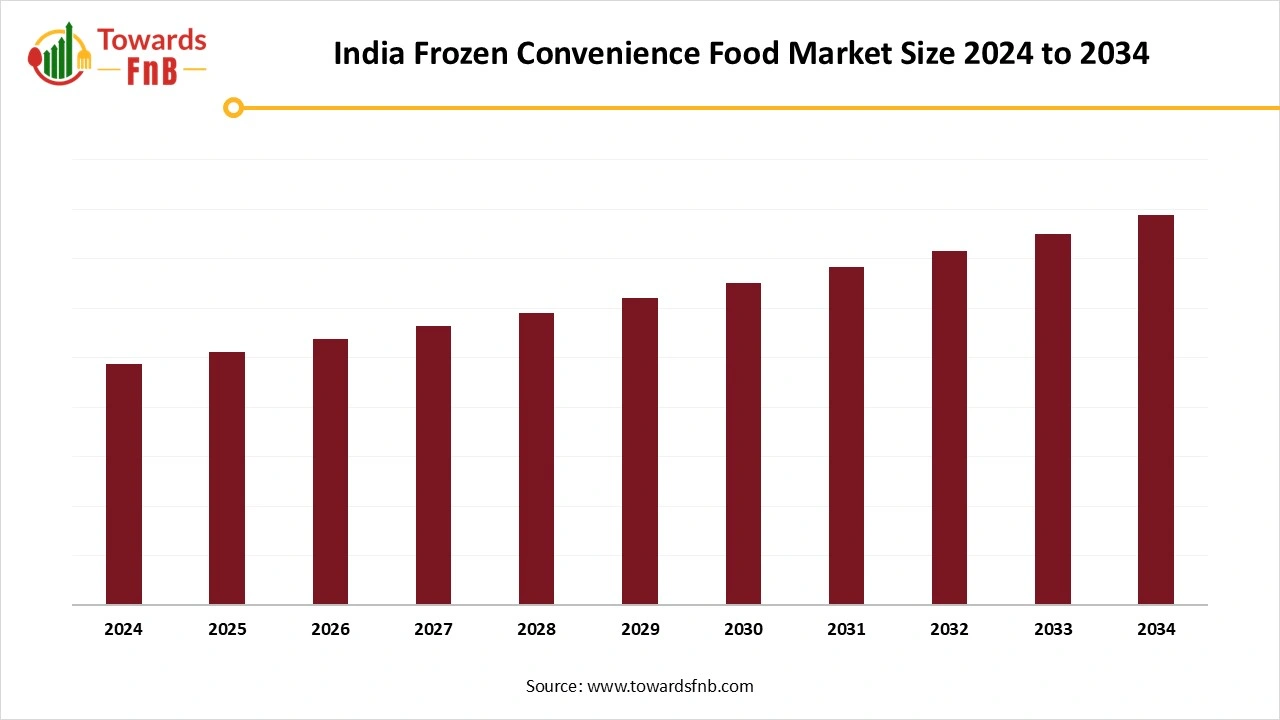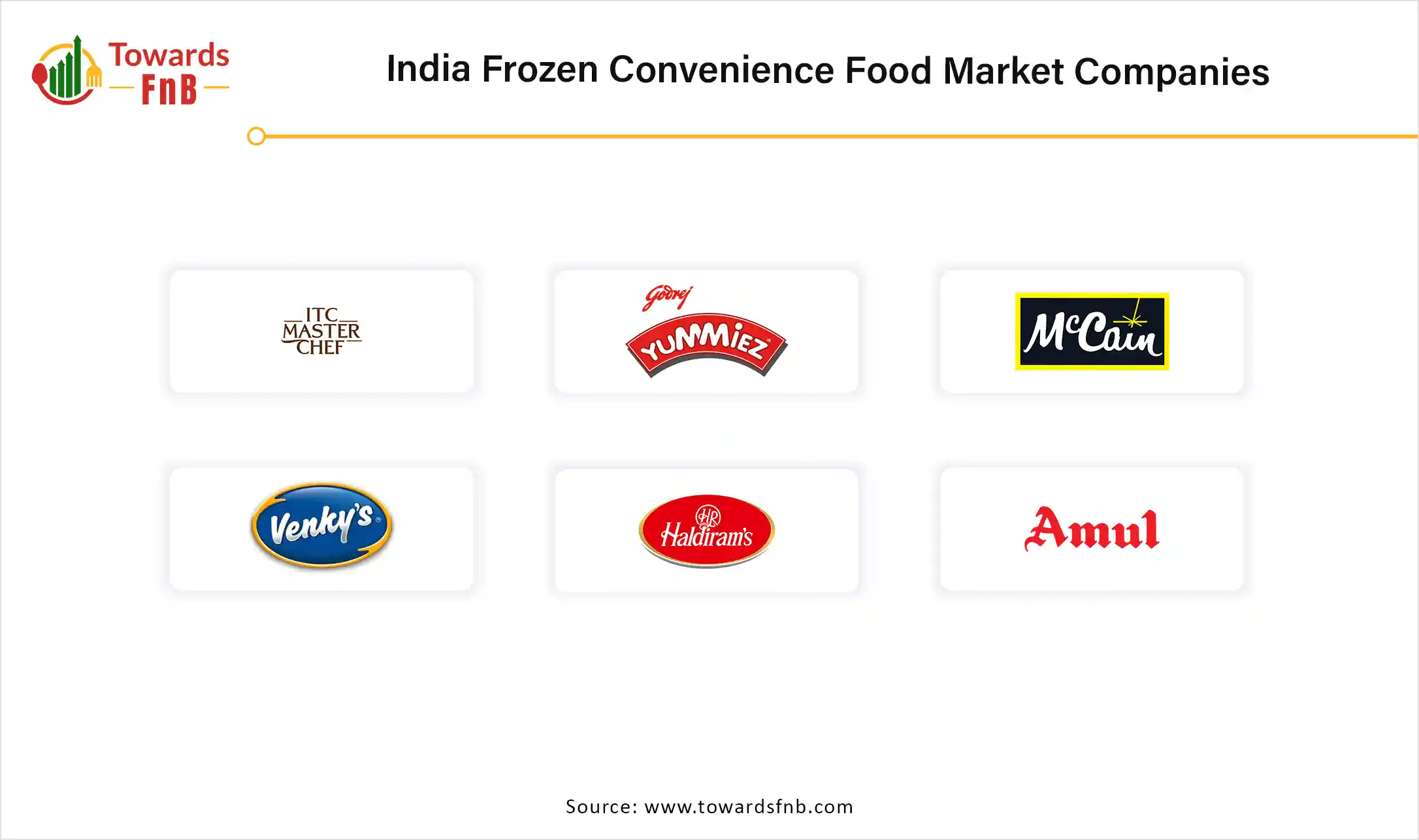December 2025
The India frozen convenience food market size is set to witness robust growth from 2025 to 2034, fueled by changing eating habits, growing demand for quick meal solutions, and increasing adoption of frozen foods among urban households seeking both convenience and taste. The increasing demand for frozen food in India drives the growth of the market.

The India frozen convenience food market includes all food products that are pre-cooked, semi-cooked, or ready-to-eat, stored at low temperatures (frozen), and sold through retail, HoReCa, and online channels for quick and easy consumption. These products are typically packaged in a way that preserves flavor, texture, and nutritional value, and are aimed at meeting the needs of urban consumers, working professionals, nuclear families, and growing middle-class lifestyles. It includes both traditional Indian cuisine and fast food options, offered in vegetarian, non-vegetarian, and plant-based varieties.
There are various significant factors driving the market growth, such as increasing consumer busy and modern lifestyles, and increasing demand for easy-to-cook and ready-to-eat foods are expected to drive the market growth in India. In addition, increasing demand for frozen food such as frozen vegetables, frozen snacks, and ready-to-cook meals is becoming a household staple, which may accelerate the demand for market.
The rising technological advancements are revolutionizing market growth. Advanced techniques such as vacuum sealing, cryogenic freezing, and quick frozen (IQF) maintain nutritional value, taste, and texture. In addition, the production processes are becoming more convenient and efficient in frozen food due to the integration of smart packaging, robotic automation, and AI-powered quality control, which may create significant growth opportunities in India. In addition, rising data-driven innovation and personalization are also transforming the frozen category, as technology becomes more integrated into consumer life, which is further expected to revolutionize the growth of the India frozen convenience food market in the coming years.
The increasing supply chain issues in frozen convenience food may create major challenges in the market. From production to the retail shelf, maintaining the integrity of the cold chain is critical. Any break in the supply chain can lead to food safety issues, product recalls, and spoilage. This can be crucial for supermarkets and grocery stores, which may create challenges in consumer satisfaction. In addition, display and storage costs, regulatory compliance, and environmental impact are other restraining factors hindering the growth of the Indian frozen convenience food market.
How West India Dominates India Frozen Convenience Food Market Revenue in 2024?
West India dominated the market in 2024. The market growth in the country is attributed to the increasing modern lifestyles and younger population, growing urbanization, growing e-commerce platforms, increasing health awareness, and increasing demand for foodservice, such as cloud kitchens and QSRs. In addition, the frozen convenience food are becoming more popular in the west India, due to their convenience, low cost, and taste. Without putting in much effort, West India is accepting this concept, as these snacks are enjoyed by all age groups, which further drives the market demand in India.
The East & North-East India is expected to grow fastest during the forecast period.
The India frozen convenience food market in east and north-east India is driven by the increasing demand in urban and semi-urban areas, increasing disposable incomes, increasing presence of a strong agricultural base, and increasing consumer preference towards ready meals and frozen snacks. Dishes such as fish curries, pav bhaji, and dhokla are popular Indian cuisines in India, which may accelerate the market demand in India.
How Frozen Snacks Dominates India Frozen Convenience Food Market Revenue in 2024?
The frozen snacks segment dominated the India frozen convenience food market in 2024. The segment growth in the market is attributed to the increasing busy and modern lifestyles, increasing demand for frozen snacks such as kebabs, cutlets, spring rolls, and samosas, growing urbanization, and increasing consumer preference towards plant-based and natural snacks in India. The frozen convenience food provides customers with a huge variety of frozen treats in India. In recent years, the frozen food industry is revolutionizing rapid growth in India. For instance, frozen ready-to-cook foods are sizable Rs 3,500 crores with a 15% growth every year.
Why the Indian Cuisine Segment Held the Largest India Frozen Convenience Food Market Revenue in 2024?
The Indian cuisine segment dominated the market in 2024. The segment growth in the Indian market is driven by various benefits such as boosting immunity, vegetarian-friendly cuisine, promoting heart health, supporting weight management, providing strength and energy, being good for digestion, and being rich in nutrients. India is the largest country in the various types of cuisines. 75% of production of Indian egg consumed by the 25% of the population living in semi-urban and urban areas, there are various consumer preferences towards Indian cuisine. With 80% of the tea produced consumed domestically, India is the largest tea consumer, which further drives the segment growth.
How the Vegetarian Segment Dominates the India Frozen Convenience Food Market Revenue in 2024?
The vegetarian segment dominated the market in 2024. The segment growth in the market is attributed to factors such as the increasing growth in foodservice, the growing middle-class population, rapid urbanization, rising innovation in vegetarian frozen products, increasing consumer trend towards vegan and flexitarian diets, increasing health awareness, and increasing dietary preferences. To support the body and environment, everyone in India is shifting vegetarian diet. With 38% of its total population, India claims the top spot.
What Factors Help Flexible Pouches Segment Grow in 2024?
The flexible pouches segment dominated the India frozen convenience food market in 2024. The segment growth in the market is propelled by the increasing growth in e-commerce platforms, increasing demand for single-serve and on-the-go packaging, increasing consumer preference towards lightweight packaging and sustainability, the growing food and beverage industry, and rising technological advancements in packaging solutions. Indian companies made complete 100% paper material and provide a biodegradable and eco-friendly option for storage and packaging.
How Modern Retail Segment Dominates India Frozen Convenience Food Market Revenue in 2024?
The modern retail (supermarkets/hypermarkets) segment dominated the market in 2024. The segment growth in the Indian market is driven by factors such as increasing consumer desire to shop physically without waiting for delivery, increasing product discoverability, greater understanding of buyer behavior, improved operational efficiency, and increasing consumer preference towards offline stores.
Why Households Segment Held the Largest India Frozen Convenience Food Market Revenue in 2024?
The households segment dominated the India frozen convenience food market in 2024. The segment growth in the market is attributed to the increasing consumer preference towards home cooking, rising expansion in online and retail grocery stores, growing middle-class population, and increasing consumer awareness towards health and well-being. In addition, to reduce the food waste in households, home freezing of fresh foods has been advocated as an approach, which further expected to accelerate the demand for frozen convenience food in India.
Conagra Brands, Inc.
Nestle
Home Bargains

By Product Type
By Cuisine Type
By Category
By Packaging Type
By Distribution Channel
By End-User
December 2025
November 2025
November 2025
November 2025